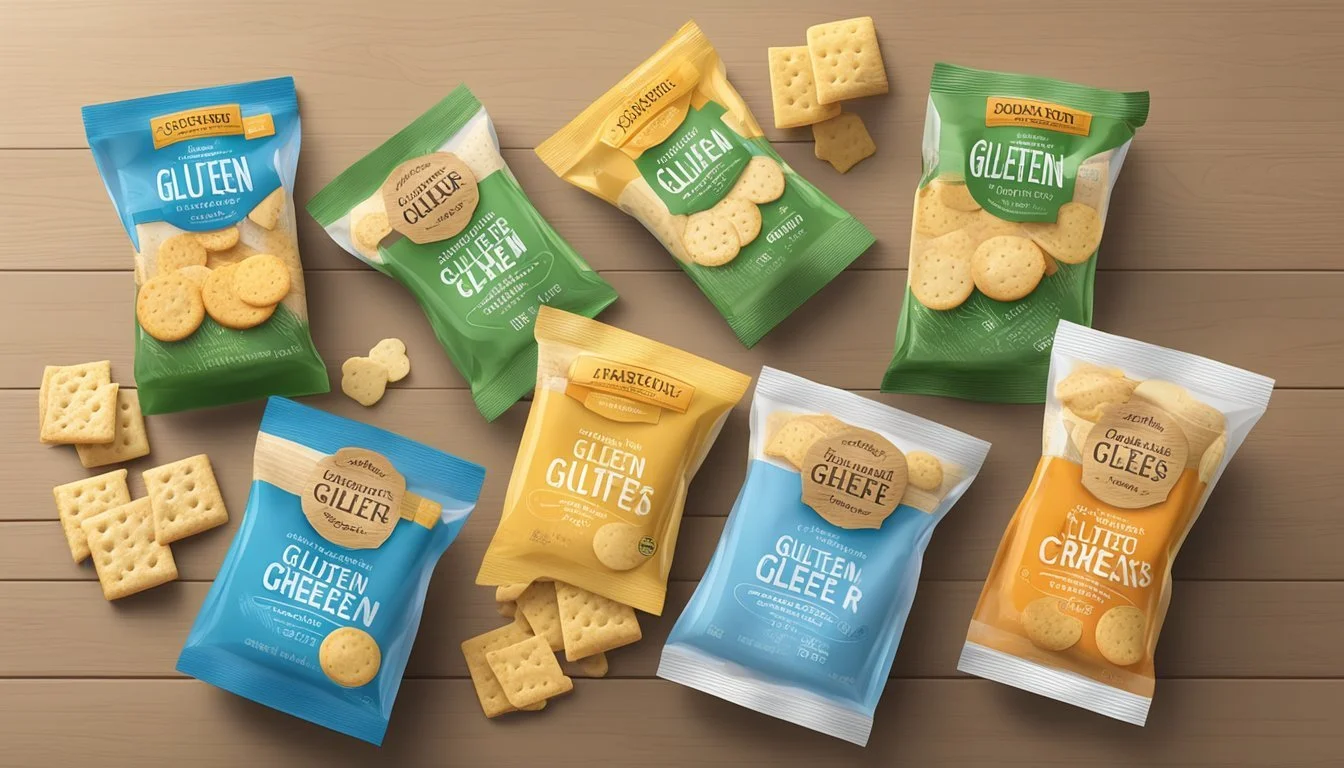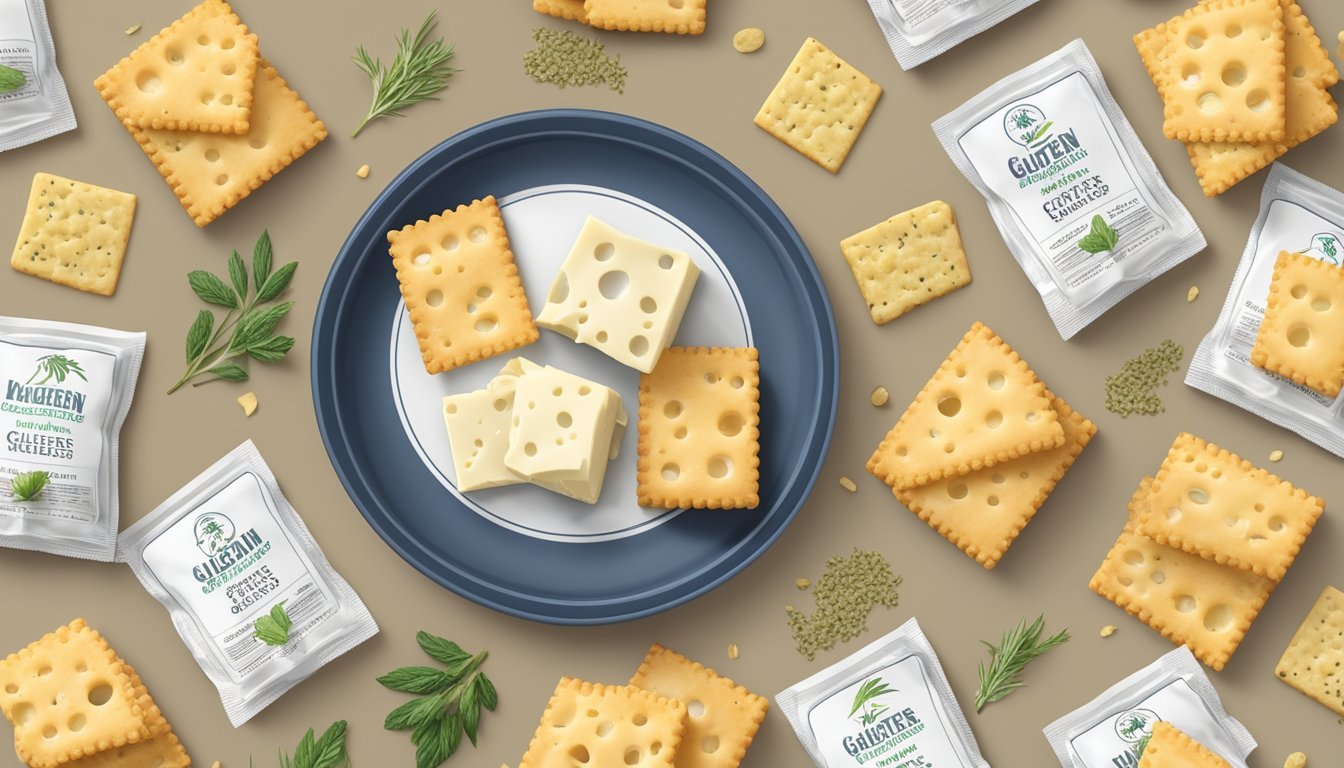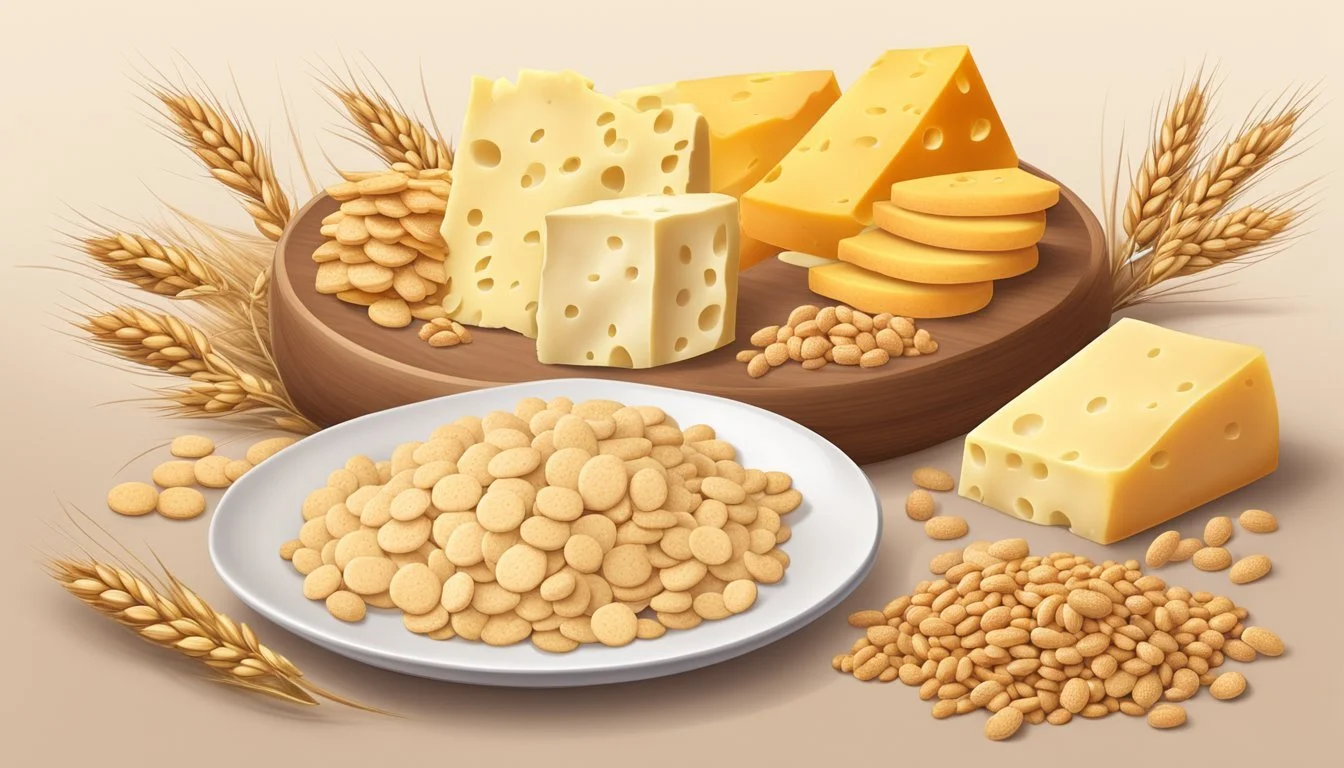Are Cheese Crackers Gluten-Free?
Unveiling the Truth About Snack Ingredients
When delving into the realm of snacks, cheese (What wine goes well with cheese?) crackers often come to mind as a popular choice. However, those with gluten sensitivities or celiac disease face the challenge of determining which cheese crackers are safe for their dietary needs. Gluten, a protein found in wheat, barley, and rye, is a common ingredient in crackers, making most traditional cheese crackers unsuitable for a gluten-free diet.
Fortunately, the food industry has responded to the increasing demand for gluten-free options, and a variety of gluten-free cheese crackers are now available on the market. These crackers are made with alternative flours such as almond, rice, or blends that do not contain gluten. While these alternatives offer a safe snack for those avoiding gluten, it's essential to check labels for certification and to be aware of potential cross-contamination in facilities that also process gluten-containing products.
Consumers can find gluten-free cheese crackers that not only meet their dietary needs but also satisfy their cravings for a cheesy, crunchy snack. Brands often provide detailed information on their manufacturing processes and may include certifications from gluten-free organizations to assure customers of the product's safety. It is always advisable to conduct research and select brands that are transparent about their ingredients and cross-contamination prevention measures.
Understanding Gluten-Free Diets
Navigating a gluten-free diet can be imperative for individuals with celiac disease, as well as beneficial for those choosing to reduce gluten intake. Attention to food labels and understanding cross-contact are crucial for maintaining such a diet.
Celiac Disease
Celiac disease is an autoimmune disorder triggered by the ingestion of gluten, a protein found in wheat, barley, and rye. When individuals with celiac disease consume gluten, their immune system reacts by damaging the small intestine's lining, leading to malabsorption of nutrients and a host of digestive and non-digestive symptoms. Following a strict gluten-free diet is the only current method to manage celiac disease, which requires avoiding all foods that contain gluten, including many types of bread, pasta, and cereals.
Gluten-Free Snacking
Snacking while adhering to a gluten-free diet means ensuring that the snacks, such as cheese crackers, do not contain gluten ingredients or haven't been subject to cross-contact with gluten. Cross-contact can occur when gluten-free foods come into contact with gluten-containing foods or surfaces, making otherwise gluten-free options unsafe for consumption by individuals with celiac disease. It is important to verify if packaged snacks are labeled gluten-free and to be aware if they are processed in a facility that also processes wheat or other gluten-containing grains.
Here is a brief list of gluten-free ingredients commonly found in gluten-free cheese crackers:
Rice flour
Tapioca starch
Cornstarch
Xanthan gum
It is also wise to look for reputable gluten-free brands and read ingredient labels carefully, as some products may still contain traces of gluten due to shared manufacturing environments.
What Makes a Cracker Gluten-Free?
Achieving a gluten-free status for crackers hinges on careful selection of ingredients that are free from gluten-containing grains. The outcome relies on substitutes that maintain the desirable texture and flavor while complying with gluten-free dietary restrictions.
Gluten-Free Flour Blend
A gluten-free flour blend typically replaces wheat flour in the recipe, ensuring the crackers are safe for those with gluten sensitivities. Almond flour is a common base owing to its nutritional profile and mild flavor. Other components might include rice flour, tapioca starch, or potato starch to mimic the texture of traditional flours. Xanthan gum is often added to gluten-free flour blends to replace the elasticity and stickiness that gluten provides in dough. For rising, a gluten-free baking powder is necessary, as some baking powders may contain gluten.
Common Flour Blend Components:
Almond flour
Rice flour
Tapioca starch
Potato starch
Xanthan gum
Gluten-free baking powder
Gluten-Free Ingredients
Beyond the flour, every other ingredient must also be gluten-free. Common ingredients in gluten-free cheese crackers include dairy-free cheese for lactose-intolerant individuals, butter for richness, and sea salt for flavor enhancement. An egg may be used as a binder to help the cracker ingredients cohere without gluten. Each additive, down to the spices and seasonings, must be verified gluten-free to protect consumers with celiac disease or gluten intolerance.
Other Gluten-Free Ingredients:
Dairy-free cheese or regular cheese (if not lactose intolerant)
Butter (or dairy-free alternative)
Sea salt
Egg (optional, as a binder)
Cheese Crackers and Gluten
When exploring the world of cheese crackers, it is crucial to distinguish between traditional recipes and those designed for gluten-free diets. This section examines the typical components of cheese crackers and the gluten content in notable brands.
Common Cheese Cracker Ingredients
Typical cheese crackers combine ingredients such as wheat flour, cheddar cheese, salt, and butter. However, variations arise in formulations for gluten-free alternatives. Gluten-free cheese crackers often substitute wheat flour with blends of rice, almond, or other gluten-free flours. Additionally, these gluten-free options may incorporate xanthan gum to mimic the binding quality that gluten provides.
Gluten Content in Popular Brands
The gluten content in cheese crackers can vary widely between brands.
Simple Mills Sea Salt Almond Flour Crackers: Made with a gluten-free flour blend, these crackers are suitable for those avoiding gluten.
Mary's Gone Crackers Original and Real Thin Crackers: Both selections offer a blend of nuts and seeds, and they are recognized for their gluten-free composition.
Lance: While Lance offers gluten-free varieties, the brand manufactures its products on shared equipment; however, they implement measures to prevent cross-contact with gluten.
Ritz Crackers: Traditionally include wheat flour and are not gluten-free.
Absolutely Gluten Free, Ka-Me Gluten Free Sesame Rice Crackers, and Crunchmaster: These brands provide gluten-free options, which typically replace wheat flour with other gluten-free alternatives.
Consumers must check packaging and brand statements for information on gluten content and potential cross-contamination with gluten to ensure the crackers meet their dietary needs.
Homemade Gluten-Free Cheese Crackers
Crafting gluten-free cheese crackers at home is an enjoyable way to create a snack that suits dietary restrictions while not compromising on flavor. With the right ingredients and baking techniques, you can make crispy, flavorful cheese crackers that rival any store-bought variety.
Choosing the Right Ingredients
For a successful batch of gluten-free cheese crackers, selecting suitable alternatives to traditional wheat flour is essential. A quality gluten-free flour blend is the cornerstone of your recipe, providing the necessary structure without gluten. Blends typically include rice flour, potato starch, and tapioca flour, among others. To ensure cohesiveness, add xanthan gum if it's not already included in your flour blend.
Cheese is the star ingredient, and you have flexibility: grated cheese like sharp cheddar provides a classic taste, while shredded cheese such as asiago or parmesan adds a more complex flavor profile. For a spicy kick, consider incorporating a pinch of cayenne pepper. Other dry ingredients like sea salt, onion powder, or additional spices can be adjusted to suit your palate.
Unsalted butter helps bind the dough and adds richness to the crackers, while sufficient water is key to the right dough consistency. For equipment, a food processor can make quick work of combining the dry ingredients with butter and cheese, though the task can also be done by hand.
Baking and Storage Tips
Once your dough is prepared, it should be rolled out between two pieces of parchment paper to a thickness of about 1/8 inch for optimal crispiness. A pastry wheel or pizza cutter can be used to cut the dough into squares or other shapes, using cookie cutters for variety.
To prevent puffing during baking, poke each cracker with a fork to create small holes. Bake the crackers on parchment-lined baking sheets in a preheated oven following your recipe's temperature guidelines. Keeping an eye on the batch is critical since gluten-free items can brown quickly.
After baking, let the crackers cool completely on a wire rack before storing them in an airtight container to preserve moisture and crispness. Properly stored, they can last for several days, maintaining their snap and flavor for reliable snacking.
Nutritional Considerations for Gluten-Free Cheese Crackers
When considering gluten-free cheese crackers, one must examine both their nutritional content and ingredient composition. Gluten-free does not inherently mean healthier, so it is crucial to evaluate the specific ingredients and nutritional information to ensure they align with dietary needs.
Healthy Alternatives
Gluten-free cheese crackers offer a variety of healthy alternatives to traditional crackers, particularly for those with celiac disease or gluten sensitivity. Ingredients often include a blend of gluten-free flour and xanthan gum to mimic the texture of regular crackers. However, the nutritional value can differ significantly based on the choice of flour and addition of other ingredients. For instance, a gluten-free cracker that incorporates granola may offer additional fiber and nutrients.
Dairy alternatives, such as dairy-free cheese, are commonly used when the product is also catering to a vegan or dairy-free audience. Cheeses like parmesan or white cheddar, when labeled gluten-free, can offer a rich flavor without gluten contamination. It is important to look for shredded cheese marked as gluten-free to avoid potential cross-contact with gluten-containing ingredients in the facility where they are processed.
Nutritional Profile Sample:
Total Fat: Varied, look for low saturated fats
Sodium: Check for low sodium options
Fiber: Higher fiber content preferred
Protein: Cheese alternatives may vary in protein content
Understanding Food Labels
The key to selecting suitable gluten-free cheese crackers lies in understanding food labels. Legally, gluten-free products must contain less than 20 parts per million of gluten. Manufacturers may also include preservatives to extend shelf life, which should be noted by consumers concerned with additives.
Label Checklist:
Gluten-Free Certification: Verify the presence of a gluten-free label
Ingredients: Identify whole foods over processed
Allergens: Look for potential cross-contaminants
Nutritional Information: Assess calorie count, macronutrient balance, and serving size
Consumers should not only seek the gluten-free label but also assess if the product meets other nutritional needs, such as reduced preservatives or suitability for a vegan diet. Gluten-free cheese crackers can be a safe and tasty snack when one pays close attention to these details.
Purchasing Gluten-Free Cheese Crackers
When shopping for gluten-free cheese crackers, consumers have a variety of brands to choose from, and it is crucial to read packaging and labels to ensure the product meets gluten-free standards.
Available Brands and Varieties
Several brands offer gluten-free cheese cracker options, catering to the need for tasty snacks without gluten. Notable among these are Mary's Gone Crackers and Simple Mills. Mary's Gone Crackers provides options like the Original Crackers and Real Thin Crackers, packed with nuts and seeds, which are free from gluten. Simple Mills has gluten-free options like Sea Salt Almond Flour Crackers that pair well with cheeses and spreads. Another popular brand is Blue Diamond, which produces Almond Nut Thins in a Cheddar Cheese flavor, providing a crunchy, savory snack. It’s important for shoppers to explore the various gluten-free cheese cracker varieties available to find their preferred taste and texture.
Reading Packaging and Labels Accurately
Identifying gluten-free cheese crackers requires close attention to packaging and labels. Brands such as Absolutely Gluten-Free offer Grain-Free Cracked Pepper Crackers bearing clear gluten-free labeling. When examining cracker labels, shoppers should look for certifications from organizations like the Gluten-Free Certification Organization (GFCO), which adds an extra layer of assurance. Key phrases to look for include "certified gluten-free," "no gluten," or "free from gluten." Additionally, consumers should check for mentions of cross-contamination risks if the crackers are produced in facilities that also process gluten-containing products. This vigilance in reading labels ensures that individuals with celiac disease or gluten sensitivity can confidently enjoy gluten-free snacks.
Shoppers can also consider crackers like Ka-Me Gluten-Free Sesame Rice Crackers as alternative options that are inherently free from gluten, expanding the range of choices. By understanding the available brands and carefully reading packaging, individuals can make informed decisions while purchasing gluten-free cheese crackers.
Tips for Gluten-Free Cheese Cracker Enjoyment
Navigating the snack world can be challenging for those with gluten sensitivities, but enjoying gluten-free cheese crackers doesn’t have to be limiting. A variety of flavors and pairings are available to make this snack both satisfying and exciting.
Pairing With Other Foods
Gluten-Free Cheese Crackers lend themselves seamlessly to a range of pairings. They hold their own next to a bowl of soup, particularly tomato or butternut squash, as they provide a satisfying crunch. For a more substantial snack, one might consider topping cheese crackers with a slice of gluten-free pepperoni or salami, transforming them into a mini pizza experience.
Fresh or Dried Herbs can be added to elevate the flavor profile—think rosemary, thyme, or oregano. Serving alongside a fruity jam or a sharp cheddar provides a contrast that excites the palate.
Pairings with Gluten-Free Cheese Crackers:
Tomato or butternut squash soup
Gluten-free deli meats (e.g., pepperoni, salami)
Fresh fruit (apples or grapes)
Spreads (fig jam, raspberry preserves)
Creative Serving Ideas
Stack Them Up: One can create a stacked snack by layering cheese crackers with other gluten-free toppings such as thin cucumber slices, a dab of hummus, or shredded rotisserie chicken for a quick, flavorful bite.
DIY Snack Mix: Combine them with other gluten-free items like popcorn, pretzels, and nuts to create a custom snack mix. Alternating flavors and textures keep snacking fresh and engaging.
Creative Serving Combinations:
Cucumber and hummus on a cracker
Rotisserie chicken and a dab of mustard
Homemade trail mix with gluten-free crackers, popcorn, almonds, and dried fruits
One can find gluten-free cheese crackers from brands like Back to Nature and Breton, which seek to deliver the traditional snack experience without the gluten. When selecting gluten-free snacks, always review labels to ensure they meet dietary needs.
Conclusion
Cheese crackers can be both gluten-containing and gluten-free, depending on the brand and ingredients used. Individuals with celiac disease or gluten sensitivity should opt for products that are clearly labeled as gluten-free. Brands like Breton offer gluten-free options, including flavors like Herb and Garlic, and Original with Flax. Another option is Mary's Gone Crackers, which are known for their nutritious composition and suitability for gluten-free diets.
For those who prefer homemade alternatives, recipes are available that allow for control over the ingredients, ensuring the crackers are gluten-free. Key ingredients to avoid include wheat flour and any additives that may contain gluten. Instead, it's advised to use gluten-free flours and to be vigilant about cross-contamination during preparation and baking.
In summary, consumers have access to both commercial and homemade gluten-free cheese cracker options. When purchasing store-bought crackers, looking for gluten-free labels and certification is crucial. For homemade recipes, selecting safe ingredients and preventing cross-contamination are the keys to enjoying cheese crackers without concerns of gluten exposure.







